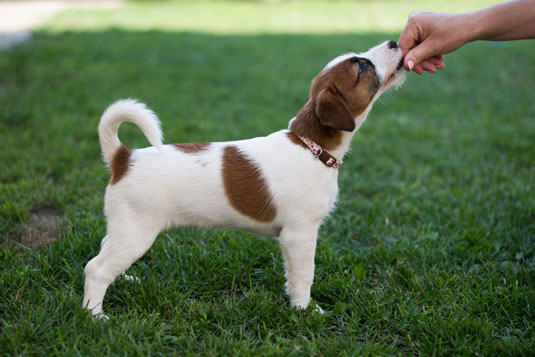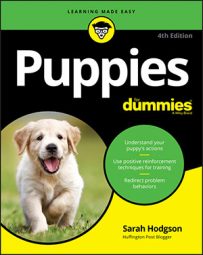Teaching commands for puppy obedience
To train your puppy, pair the following basic puppy command words with each specific action and use them consistently. Give positive reinforcement with treats and attention, and start early: The younger your puppy is when you start, the more attentive the puppy will be to directions and ideas.

Jack Russell Terrier puppy in training.
-
“Follow.” This command says, “I’m the leader, so follow me!” Say it whenever you’re leading your puppy on leash.
-
“Sit.” This direction is the human equivalent of “Say please.” Direct your puppy to sit before giving anything positive, from meals and treats to toys, or when greeting strangers or friends.
-
“Down.” Directing “down” helps your puppy calm down whenever you’re going to be stationary for a while.
-
“Stay.” This direction instills good impulse control. Direct your puppy to stay whenever you want him or her to be still.
-
“Wait.” Use this direction for sudden stops or at curbs. It says, “stop and focus on me before proceeding.”
-
“No.” This direction is the human equivalent of “that’s a bad idea” instead of “you’re bad.” Use it if you catch your puppy thinking about misbehaving.
-
Everyday instructions: Assign a command to everyday actions, like going upstairs, going outside, coming inside, getting in the car, and so on.
Sample house-training schedule for puppies
This house-training schedule is based on the needs of a healthy four-month-old puppy. Vary the schedule according to your schedule and the age needs of your pup. If you can’t take care of all your pup’s needs due to your work schedule or other conflicts, consider hiring a helper.
| Period of Day/Time | Action |
|---|---|
| Wake up (7 a.m.) | Go to potty area (outside or papers) immediately and only for a potty break. |
| Breakfast (7:30 a.m.) | Fill the bowl and encourage your puppy to sit before placing it down. |
| Morning walk (8 a.m.) | Play after breakfast and/or take a walk. |
| Late-morning walk (11 a.m.) | Play, potty, and/or take a walk. |
| Lunch (11:15 a.m.) | Young puppies must eat and then go to their potty area. Fill the bowl and encourage your puppy to sit before placing it down. |
| After-lunch outing (11:45 a.m.) | Potty break. |
| Midafternoon walk (2:30 p.m.) | Play, potty, and/or take a walk. |
| Pre-dinner outing | Potty break. |
| Dinnertime (4:30 p.m.) | Fill the bowl and encourage your puppy to sit before placing it down. |
| After-dinner outing (5 p.m.) | Play, potty, and/or take a walk. |
| Evening (7:30 p.m.) | Remove water. |
| Late evening (8:30 p.m.) | Potty break. |
| Before bed (11 p.m.) | Potty break. |
| Middle of the night | Potty break if necessary. |

